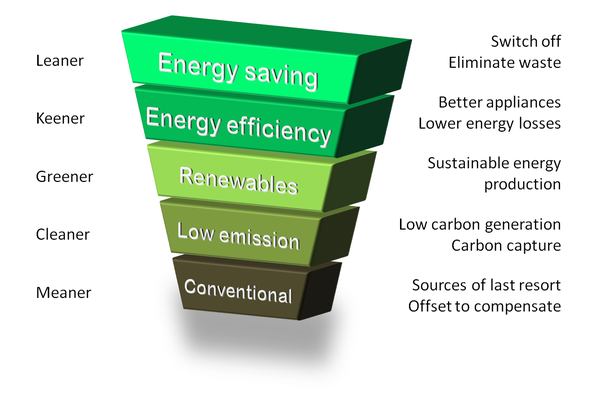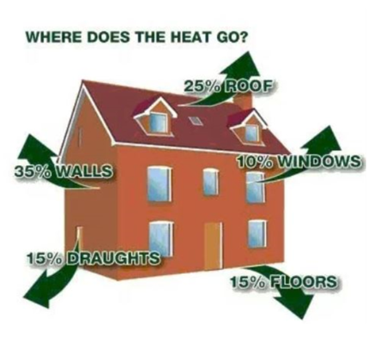The Retrofit Journey
Before considering the installation of renewable energy sources, such as solar panels and air source heat pumps, it is essential that other features of the property which may be a source of heat loss are addressed. The things to consider could be improving ventilation, roof/loft insulation, draught proofing or the type of window glazing.
It is beneficial to think about these before installing solar panels or heat pumps. You may find that just by improving the thickness of the loft insulation, the efficiency of the current boiler or insulating under floors, you could sufficiently reduce energy costs without the need to install more expensive renewable features.
Each home is unique, so there is no one size fits all approach. Every property will need to be assessed individually, looking at a whole house system approach using the Energy Hierarchy.
 |
This approach will provide a programme of measures to be completed in the right order.
Using a Fabric First approach prioritises repairs, insulation, draught proofing, ventilation and double / triple glazing before alternative renewable energy sources - solar panels, heat pumps etc. are installed.
This holistic approach includes external (outdoor) and internal (indoor) elements as well as assessing how people use the building - are you out all day, working from home all or part of the week, single occupancy, family with young children etc..
There are two stages to the retrofit journey.
Stage 1 of retrofitting is the same as all the Cost of Living energy saving actions that are widely suggested to reduce energy use and save money.
The aim is to reduce the heat lost from our homes via our doors, windows and uninsulated walls and roofs. The heat loss percentages for a typical house are:
|
|
- walls 35%
- roofs 25%
- floors 15%
- draughts 15%
- windows 10%
Stage 2 is a Whole House Assessment or Dwelling Condition Survey, which needs to be carried out by a qualified professional to:
- identify how the property is used by its occupants
- assess ventilation to reduce draughts and install mechanical ventilation if required
- identify sources and causes of moisture
- assess building construction for signs of movement, settlement, dynamic cracks or issues of concern
- assess the effects of wind driven rain on building materials
- identify features that may introduce weak points where heat can escape (thermal bridges), such as adjoining walls, sheds, meter boxes, conservatories, insufficient clearance around window reveals.
The Whole House Assessment Report will identify building fabric improvements that need to be made prior to changing to renewable energy sources.
Doing things in the wrong order may mean you spend more than you need to or may make future improvements harder. For example, there is no point installing a new heating system without sorting out the heat loss issues that already exist.
While we can't give a specific value on savings, it is expected that retrofitting will save £200 - £1000 per year in energy costs. Savings will depend on how inefficient the property was prior to work, how much has been upgraded, future fuel prices, and the temperature requirements of the home.
If ventilation of a property is improved (while keeping temperatures correct and minimizing energy use) this will also improve indoor air pollution.


